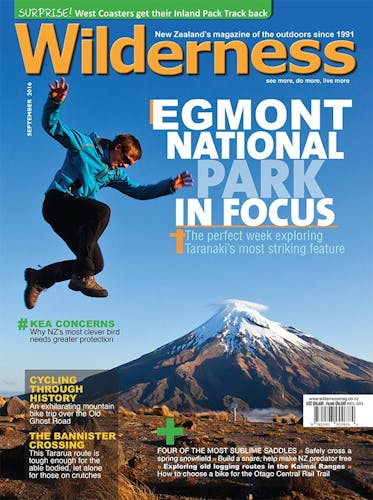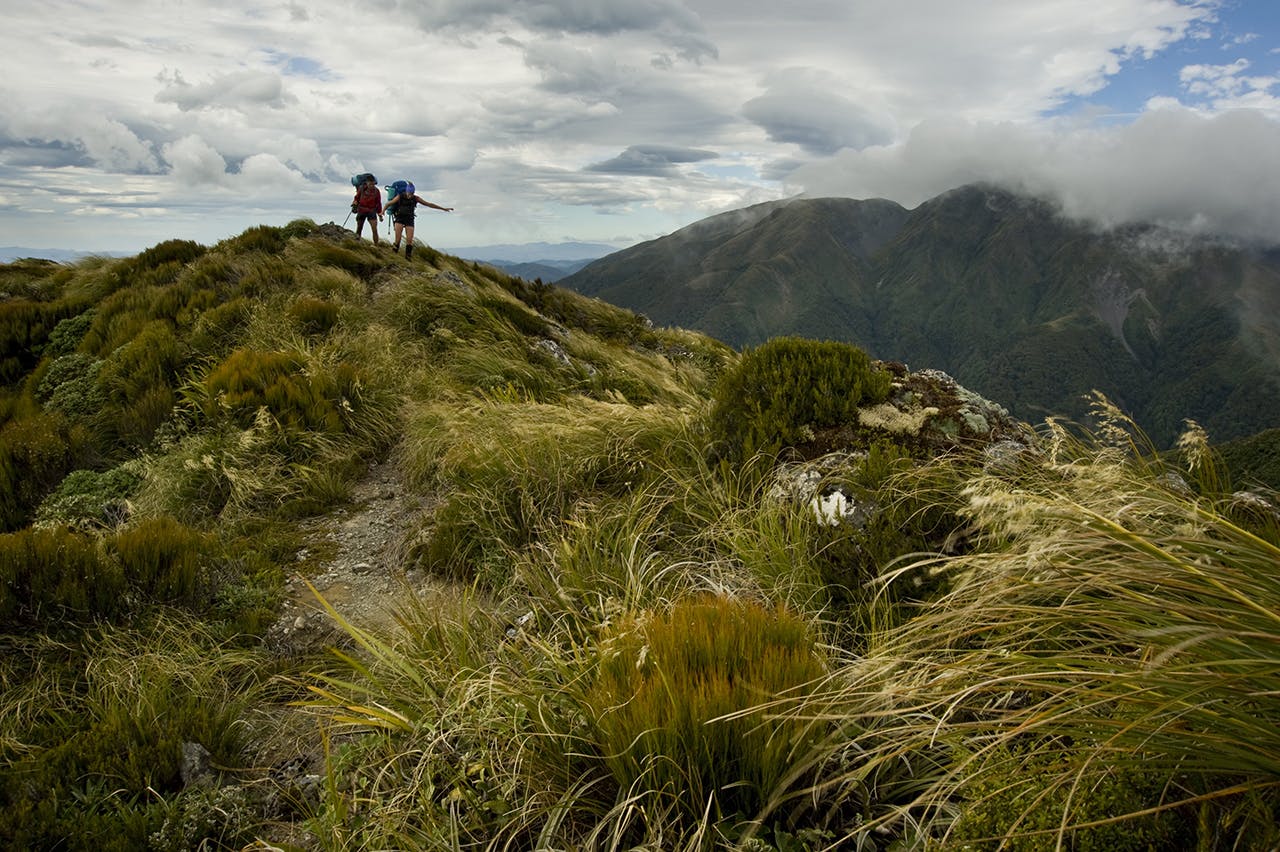- Distance
- 33.1km
- Total Ascent
- 3305
- Time
- 3-4 days
- Grade
- Difficult
- Access
- From Kiriwhakapapa Campsite, at the end of Kiriwhakapapa Road and off SH2
- Map
- BN33, BN34
- Links/Files
-
Download the route notes, maps and GPX file
To mark Wilderness magazine’s 30th anniversary, current and past editors and contributors scoured the archives for the 30 best trips we’ve published over the decades. This story, original published in September 2016, was included. You can find all 30 of the greatest Wilderness trips in the October 2021 issue.
Some say the Bannister is the toughest crossing in the Tararuas. When you’ve got a pair of crutches strapped to your pack, they’d be right.
It was a familiar Tararua scene.
Three of us in a shrunken world; a world reduced to mist, tussock and the bullying wind. We were attempting a crossing of Bannister, which has the reputation of being among the most arduous of all the Tararua’s many ridges.
Three trampers, lurking in the mist, lugging lumpy packs and lurching at strange angles to counter the erratic gusts. Nothing out of the ordinary, except, what was that strapped to the side of Heather Rhodes’s pack?
A pair of green crutches.
Crutches?
In 2013, Heather fell 300m while climbing in the Arrowsmith Range. It’s been three long years of remarkable recovery (see Wilderness, April 2015). Her re-entry into the alpine world began with tramping and after hearing of my planned Bannister Crossing, she was keen to come along. On her last tramp, a week or so before, she needed to use the crutches on the descent. This time, she was hoping not to have to rely on them.
A gaping scar on her lower leg shows one of the injuries she sustained, which also included a broken neck, spine, arm, leg and nose. Less obvious is the metal plate in her other leg, and the complications of the head injury that left her in a coma for eight days.
In such circumstances, tackling the Bannister Crossing might seem a little foolish, but Heather has been carefully building up to this. And we’re under the expert guidance of Tararua veteran Joe Nawalaniec, who’s done a Bannister Crossing more times that he cares to remember: in rain, in mist and in scorching sunshine. He’s escorted teenagers from Rathkeale College over the route, and reckons it’s a trip they usually don’t forget.
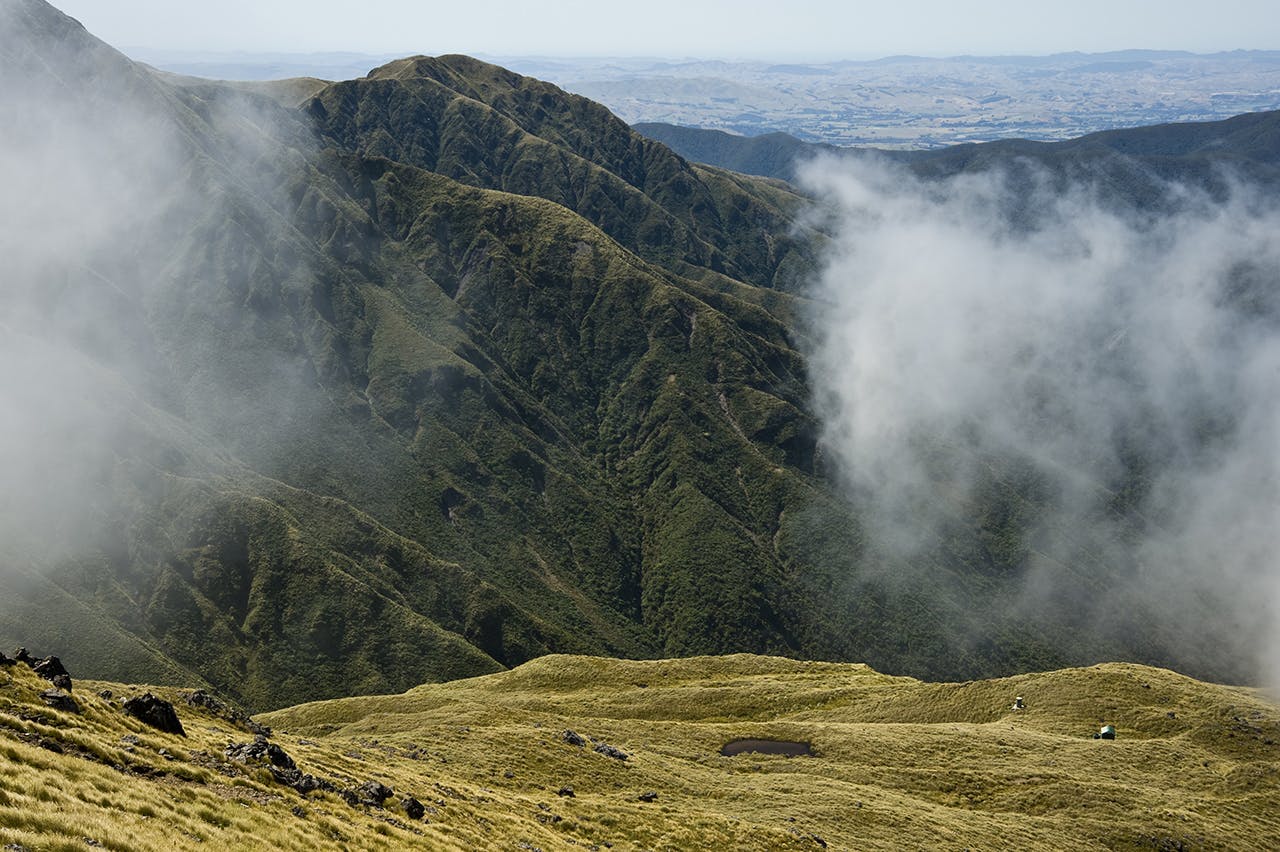
Clearing mist reveals Arete Hut. Photo: Shaun Barnett/Black Robin Photography
The wind, though, was proving to be a problem. Heather’s balance was affected by her head injury, and the erratic gusts played havoc with her stance, sapping her energy. We took a breather at the tarn below Waingawa Peak and waited. Sometimes that’s the best decision you can make: to not make a decision and see what happens.
Heather’s father, John Rhodes, if not physically present on the trip, was morally present. What would John have done? Made a billy of tea. We brewed-up beside the tarn, gulped steamy mouthfuls and watched the mist swirl and circle around the spurs and ridges.
Then, rather rapidly, our world opened up again. The mist began to recede. Patches of blue sky showed. The view of the Waingawa on one side and the Ruamahanga on the other opened up like a dance of unveiling shrouds.
And, most pleasing of all, the wind dropped to almost nothing.
It’s occurred to me more than once that one of the great contrasts of tramping is these sudden changes; one minute you’re in a shrinking world, the next expansive. Yesterday we’d been enclosed in forest, a world of green fern fronds and beech trees, then emerged at Blue Range Hut to enjoy the sight of a big blue sky, a small blue hut and the distant blue sea. That night, the world had shrunk to the interior of Joe’s tent, where we had camped at the Waingawa bush edge. Above the bushline, it had expanded into acres of tussock ridges, a gaping green valley below and a great open sky above. But then, just as quickly, it’d shrunk into grey clag.
And then – just at the perfect moment – it was growing rapidly again. We could see the contorted line of the ridge twisting and bending ahead, rising to the summit of Bannister, which was still streaming a banner of cloud.
The Bannister Ridge is traversed often enough for a ground trail to have formed following the often-narrow ridge crest. After descending to a low dip, we encountered a small cheval-like section, with a sharp drop-off to the west. Beyond, we negotiated a couple of steep knobs, then arrived at the crux of the route – a little rock-step with a short sequence of grade 8-10 rock climbing moves. Slightly awkward with a full pack, even more so when you’ve got crutches strapped to it, but do-able. Not that I’d particularly want to tackle it during rain, as Joe has done, or in the opposite (downhill) direction.
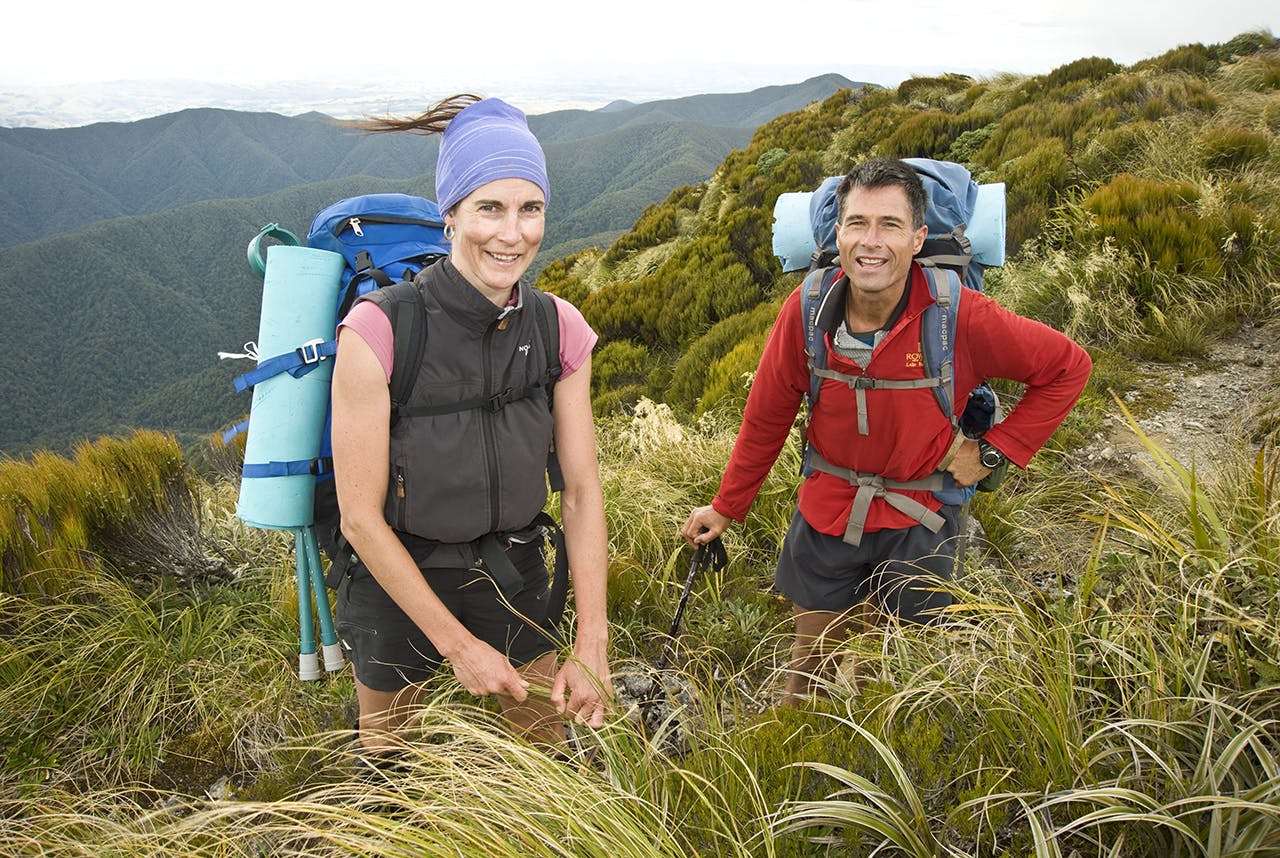
Heather and Joe before the mist closed in on Waingawa. Photo: Shaun Barnett/Black Robin Photography
More travel led to the south Bannister summit, where there is a wonderfully narrow section of ridge – quite airy, but not requiring any serious scrambling. We traversed some exquisite ledges, with alpine plants – North Island edelweiss, gentians and Maori onion – sprouting in unlikely places. By then, the mist had come in again; not menacingly so, but a nice shroud which lent the peaks a certain Gaelic charm. Finally, after a another short ascent, we were on the summit of Bannister itself.
I recalled a trip to a peak in Scotland, where I’d crested the summit only to be told by a Scottish rambler it was not a ‘Munro’ but merely a ‘Top’. We were well above Munro height; Bannister and its southern summit are both over 1500m, and I realised that I’d now bagged all the peaks in the Tararua Range over that height. Joe produced a small bottle of brandy and we all took a swig to celebrate. “You’re not just on a Top now lad,” Joe quipped. “This is a real Munro.”
The mist kept us on our toes as we navigated towards a pair of peaks known somewhat prosaically as The Twins. Joe informed us that on old Tararua maps, they were called The Dromedaries – a far more appealing name for a double-humped peak.
A prominent cairn marked the sidle route along to Arete Hut. Our arrival surprised the sole occupant, Kane, who hadn’t expected any visitors in this pea-soup mist. He graciously made room for us. With four inside, we doubled the hut’s capacity. As it lies at the junction of several routes, the small hut (built in 2007 to replace an earlier damp biv) really should have been made larger.
Drizzle dampened the scene outside, but we were snug in the hut; three sharing the two bunks and me on the floor. I’d wanted to photograph the hut with the dramatic backdrop of the Twins and Bannister behind, but the next morning Tararua clag played games of hide and seek; mostly hide. Joe and Heather had set off for Te Matawai Hut earlier, but I lingered, hoping for the perfect shot. Finally, I couldn’t wait any longer, and had to satisfy myself with a scene showing just Bannister.
Typically, the world did expand again, but only when I had caught up with Heather on the summit of Arete, another of the range’s 1500m peaks. We had a grand vista of Mitre, Girdlestone, the Kings, Logan and the upper Waiohine Valley, while the mist gradually withered away to nothing.
All summer I’d been bumping into Te Araroa thru-hikers in various parts of New Zealand, and this trip was no exception. Near Pukematawai, we ran into a German hiker. He was wearing five-fingered booties, a very small pack and said he was carrying no cooker. Instead, he ate food that didn’t need heating. Definitely a minimalist approach, I pondered, but he looked fit and capable enough. As he headed off along the Main Range, I certainly envied his speed.
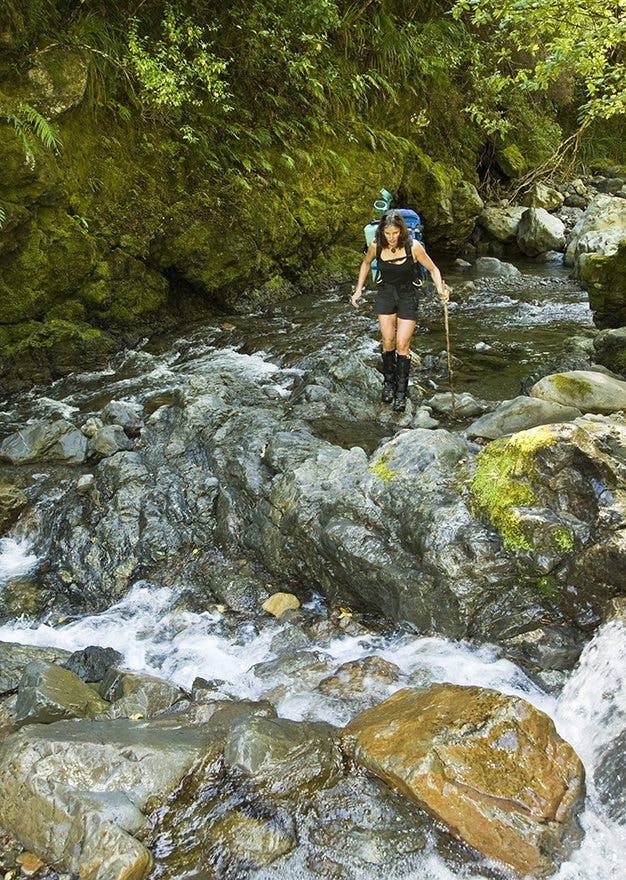
Heather Rhodes negotiating bouldery travel in the South Ohau River. Photo: Shaun Barnett/Black Robin Photography
After the big day crossing Bannister, Heather had been pretty tired, but seemed to have recovered well overnight. The crutches remained strapped to her pack. By the time we reached Te Matawai Hut, it was gloriously sunny, with views of Dundas and the western tops. A rifleman twittered in the forest, while a falcon hunted in the distance.
After a hot, humid descent down the steep ‘Yeates 500’ track to South Ohau Hut, we arrived to find more Te Araroa hikers. The hut book was full of entries from those passing through, mainly on their way south. It seems like the trail is really hitting international renown, perhaps after being voted by National Geographic magazine in 2014 as one of the world’s best. Rumours abound that 300 – 400 people attempted the whole trail this summer.
Hot and sweaty, I plunged into the cold embrace of the South Ohau River and washed away the day’s grime. It’s a sublime spot, South Ohau Hut, very nicely located on a ledge above the river, surrounded by forest, but overlooking the valley and westering sun.
Our world closed in again on our last day, which involved a leisurely splash down the narrow Ohau River. We wandered and talked, sat and brewed tea – enough to make Heather’s father proud – and lazed among the warm riverbed boulders under the summer sun. People bag the Tararua Range because of its often inclement climate, but pick the right day, and it’s paradise. “She’s holding her breath,” Joe said. And it did seem that way; the range was still and serene, a stationary anticyclone poised over the country, and the summer stretching on seemingly forever.
The bouldery travel tested Heather’s mettle, but her crutches remained redundant. She was delighted to even manage without any painkillers, which had been necessary on the first couple of days.
On the sidle track out to the farmland, we passed two Canadian Te Araroa hikers, one of them raising money for cancer. “I’ve lost my mother and aunty to cancer,” he told us.
We wished them well, and carried on to the road-end. Who would have thought the Tararua Range would have made it on to the international stage? Te Araroa, I reflected, is changing patterns of recreational use in New Zealand, and drawing a whole sub-section of trampers – long distance hikers – to our country.
I’ve heard some people gnashing their teeth over this influx of internationals, but the ones I’ve met were personable, committed and doing something fantastic with their lives – walking for months on end. In a way, they are showing up many New Zealanders who aren’t taking advantage of the great opportunities our country offers.
My two companions though, are not in that category. Joe is out virtually every week, and helps introduce dozens of young men into the tramping scene. And Heather is making a spectacular re-entry into the outdoors. The Bannister Crossing is her longest trip since the accident: four days, including some tough tramping, and a complete crossing from east to west.
I doubt anyone else will carry a pair of crutches over the Tararuas again.





